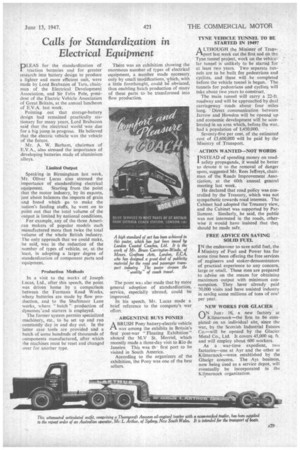Calls for Standardization in
Page 31

If you've noticed an error in this article please click here to report it so we can fix it.
Electrical Equipment PLEAS for the standardization of traction batteries and for greater research into battery design to produce a lighter and more efficient unit, were made by Lord Brabazon of Tara, chairman of the Electrical Development Association, and Sir Felix Pole, president of the Electric Vehicle Association of Great Britain, at the annual luncheon of E.V.A. last week.
Pointing out that storage-battery design had remained practically stationary for many years, Lord Brabazon said that the electrical world was due for a big jump in progress. He believed that the electric vehicle was the vehicle of the future.
Mr. A. W. Barham, chairman of E.V.A., also stressed the importance of developing batteries made of aluminium alloys.
Limited Output Speaking in Birmingham last week, Mr. Oliver Lucas also stressed the importance of standardizing electrical equipment. Starting from the point that the motor industry, by its exports, just about balances the imports of grain and bread which go to make the nation's feeding stuffs, he went on to point out that the total volume of the output is limited by national conditions.
For example, any of the three American makers of popular models each manufactured more than twice the total volume of the whole British industry. The only approach that we could make, he said, was in the reduction of the number of types of vehicle, or, at the least, in adopting a larger degree of standardization of component parts and equipment.
Production Methods In a visit to the works of Joseph Lucas, Ltd., after this speech, the point was driven home by a compariscM between the Formans Road Works, where batteries are made by flow production, and to the Shaftmoor Lane works, where "batch" production of dynamos 'and starters is employed.
The former system permits specialized machinery, etc., to be set up and run constantly day in and day out. In the latter case tools are provided and a batch of some hundreds of thousands of components manufactured, after which the machines must be reset and changed over for another type.
There was an exhibition showing the enormous number of types of electrical equipment, a number made necessary. only by small modifications, which, with a little forethought, could be obviated, thus enabling batch production of many of these parts to be transformed into flow production.
The point wa.; also made that by more general adoption of standardization, service, especially abroad, could be improved.
In his speech, Mr. Lucas made a brief reference to the company's war effort.
ARGENTINE BUYS PONIES.
A BRUSH Pony battery-electric vehicle 1"-S. was among the exhibits in Britain's first post-war "Floating Exhibition' aboard the M.V St. Merriel, which recently made a three-day visit to Rio de Janeiro. This was thfirst port to be visited in South America.
According to the organizers of the exhibition, the Pony was one of the best sellers.












































































